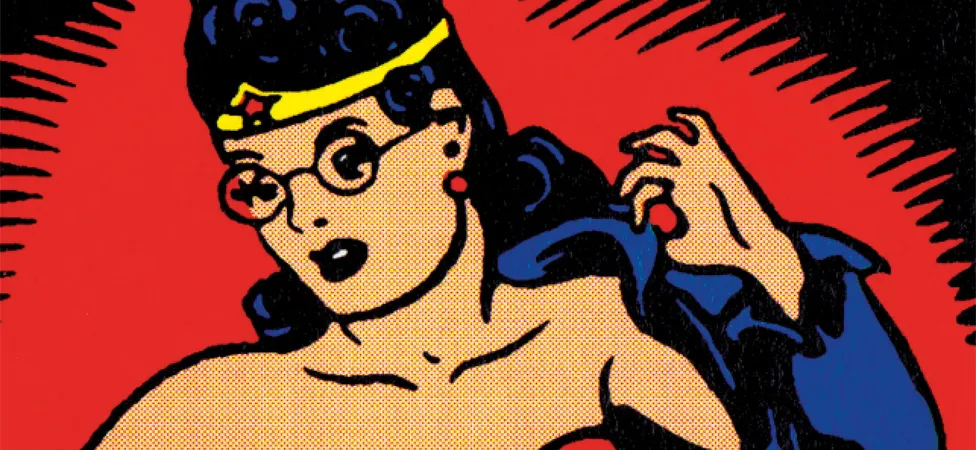Let’s play a game of “six degrees of separation.” I’m going to link Wonder Woman to one of the leaders of the birth control movement from the turn of last century, Margaret Sanger. Yes, that Margaret Sanger; the same woman who coined the words “birth control” and opened the first birth control clinic in 1916. Not only am I going to link the most popular superheroine of all time to Sanger, but I’m going to do it in two legitimate steps.
Ready? Here goes:
Wonder Woman was created by lawyer/psychologist/writer William Moulton Marston, who had what can only be described as a life-long, live-in relationship with one of his former students, Olive Byrne, whose aunt was – that’s right. Margaret Sanger.
History is so underrated, and not nearly as boring as you think.
The Secret History of Wonder Woman by Jill Lepore goes in-depth into Marston’s life and into those of his influences in order to attempt to explain the mindset from which Wonder Woman sprang forth. Concurrently, Lepore also explores the growing suffragist movement during this time, going into detail about how the movement for the woman’s right to vote grew while Marston attended college and law school. It’s also during this time that Marston would marry his childhood sweetheart, Elizabeth Holloway.
Along the way, Marston develops a love for the budding field of psychology. After graduating from Harvard Law, he eventually receives his PhD from Harvard in Philosophy. With three degrees in hand, Marston begins teaching law-based psychology classes at American College in Washington D.C. It’s here he would meet student Olive Byrne, niece of Sanger.
According to Lepore, defining Marston’s relationship with Byrne is difficult, especially in their early years. Calling it an “affair” is doing both of them (well, three of them, including Marston’s wife Holloway) a huge disservice. Lepore defines their relationship more as polygynous, something perhaps best described as akin to Sister Wives. You see, Marston lived with both Holloway and Byrne (who “married” and was quickly widowed, though Lepore writes that her betrothed was eventually revealed to be a complete fabrication). Lepore writes that a third woman, Marjorie Wilkes Huntley, would also live with them all for stints at a time.
Marston would go on to have two children with Holloway – and another two children with Byrne. At the same time. In the same house. In fact, Byrne’s second child with Marston is only six months older than Holloway’s second child with Marston. Imagine trying to explain all that to Sanger. (Actually, don’t bother. According to Lepore, Sanger was not pleased with the arrangement).
Over the years, Lepore says that Byrne has been identified by the family as everything from a live-in maid to a long-lost cousin; even after Marston’s passing in 1947 at 53, Byrne and Holloway continued to live together until Byrne passed away in 1990. On top of all this, Marston also invented the systolic blood pressure test, later and better known as the “lie detector test.” He also wrote movie scripts, worked for Universal Studios as a “psychology” consultant, and was a huckster for Gillette razors.
All before he got around to inventing Wonder Woman in the early 1940s.
Lepore writes that Marston’s relationships were highly influential in his creation of the iconic character; he apparently based her on Holloway and Byrne, right down to the bracelets Byrne wore as a sign of “unofficial” marriage to Marston (who also assisted with the writing and editing of the scripts).
Then there’s the link to Sanger. In tellings of her story, whether in writing or by spoken word, there has been no mention of the significant link between Wonder Woman and Sanger. Even her niece, Byrne, with whom she corresponded and visited with on a regular basis, is hardly ever mentioned in Sanger’s history. There’s no mention of Byrne on Sanger’s Wikipedia page. Go ahead. Check it out.
Lepore uses The Secret History of Wonder Woman to dig into Marston’s personal life in order to reveal what she believes may been influential over the creation of one of the most iconic comic book characters of all time. But Lepore’s narrative is most effective when she connects with other tales of the time from which Wonder Woman sprang forth, stories of suffrage and of the “Age of Aquarius.” It may be that, as Holloway would later claim, Marston was “living 100 years ahead of his time,” especially as we approach our first Wonder Woman film. It just goes to show that the roots of the future are always in the past.
jman is your delightfully random emissary to most things pop culturish. For even more stimulus to your cerebral cortex, check out yfnjman.com.
Are you following The Mary Sue on Twitter, Facebook, Tumblr, Pinterest, & Google +?









Published: Jan 19, 2015 08:00 pm